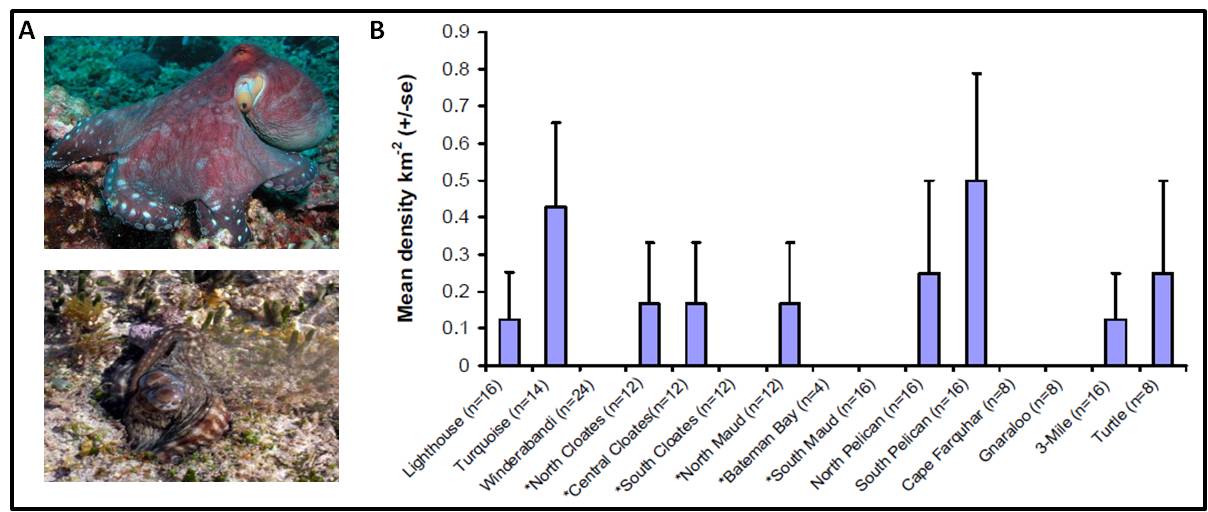Home > Browse by Themes > Biodiversity > Density of octopus in the Ningaloo Marine Park
Density of octopus in the Ningaloo Marine Park
- Australian Institute of Marine Science
- Australian Institute of Marine Science
Octopus are a commonly targeted recreational species in the Ningaloo marine Park (NMP) as their good retention on hooks make them attractive bait for pelagic and reef fishes. Considering this recreational fishing pressure on the Ningaloo octopus population, as part of a project under WAMSI 3.1.3, a quantitative estimate of octopus numbers in the NMP was conducted in 2008 to assess their patterns of distribution and their exploitation vulnerability.
One hundred and ninety four intertidal (5 x 100 m) transects covering 15 separate locations in both sanctuary and recreational management zones were sampled along the entire NMP. Octopus cyanea, a widely distributed Indo-West-Pacific tropical octopus species was identified in the surveys (Figure 1A). The distribution of octopus in the NMP was patchy, and while the northern section of the NMP contained the most octopus individuals, a very low population density of 1.2 individuals per km2 was observed (Figure 1B; see Google Earth layer below).
The patchiness of the octopus densities observed may be explained by the fact that octopus are cryptic animals that may have been missed in the surveys, or that suitable habitat is not available throughout the length of the NMP. Moreover, octopus are extremely vulnerable to human impacts by virtue of their predictable habitat requirements, clumped patterns of distribution, and relative ease of capture. As such, the history of recreational fishing of octopus in the NMP also remains a plausible explanation for the patterns of distribution and densities observed.
Population densities of O. cyanea from Africa, Asia, and the Hawaiian Islands have been reported to be abundant enough to support artisanal and subsistence fisheries. However, based on the 2008 surveys, the current number of octopus in the NMP are far too low to even support a small artisanal fishery. As such, the O. cyanea densities in the NMP are much lower than in other tropical reef systems, and without information from an unexploited octopus population, it is not currently possible to attribute these low numbers to natural factors or recreational fishing pressure.
For more detailed information on this study, see Depczynski M, Heyward A, Radford B, O'Leary R, Babcock R, Haywood M, Thomson D (2009), or contact the corresponding author, Dr Martial Depczynski.
Dataset details
| Custodian | Dr Martial Depczynski |
| Owner institution | Australian Institute of Marine Science (http://www.aims.gov.au/) |
| Spatial extent | Bundegi (21° 52' S, 114° 10' E) to Red Bluff (24° 01' S, 113° 25' E) |
| Data collection | 2008 |
| Copyright | Copyright remains with the data owner(s) |
| Reference | Click here |








